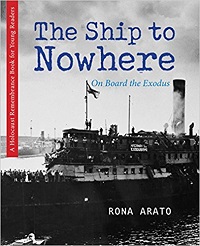| ________________
CM . . .
. Volume XXIII Number 30. . . .April 14, 2017
excerpt:
The Ship to Nowhere is a worthy addition to Second Story Press’ “The Holocaust Remembrance Series”. This series is an excellent resource for talking to children about difficult topics connected to the Holocaust. The books in this award-winning series include Shanghai Escape by Kathy Kacer and The Choice by Kathy Clark. With 16 titles to date in the series and Teacher’s Guides being available, “The Holocaust Remembrance Series” is a perfect starting point for introducing the Holocaust to children. The story found in The Ship to Nowhere is based on the true story of the ship The Exodus and its voyage in 1947 from Sète, France, to Palestine. The book is about real passengers on the ship who were travelling to Palestine in the hope of building a new life after World War II. One passenger, 11-year-old Rachel Landesman, has survived the horrors of the Holocaust along with her sister and her mother. With 4,500 people on board, conditions were not ideal, and Rachel wonders if she will ever find a new place to call home. These refuges were proud to be Jewish and grateful for their freedom and safety. Facing obstacle after obstacle, the voyage continues, culminating is a United Nations decision to create the state of Israel. First there was British interference (opposition to large scale immigration) to deal with, then the ship was sent back to France (the French resisted British attempts to make the passengers disembark), plus being threatened to have the ship dock in Germany, as well as enduring the horrible conditions on board. This journey, which received worldwide attention, prompted many to rally forces so as to provide the passengers with food, water, and ultimately citizenship. One American reporter, Ruth Gruber followed The Exodus’ voyage, and her stories helped bring attention to this ship’s journey. She witnessed the ship entering the port of Haifa and continued to follow the story, eventually writing a book in 1948 to document The Exodus’s finally arriving in Jerusalem. But Rachel, the main character, is not having a normal childhood. She survived the Holocaust, but with British war ships surrounding The Exodus, Rachel realizes that life isn’t always what it seems. Yes, she tries to be a child, playing games, enjoying new friendships, and she realizes how lucky she is to have family on board with her since many others do not know the fate of many of their relatives. The book ends with Rachel and the other passengers finally disembarking in Haifa. Rachel knows that one must keep hope for, without hope, nothing is possible. Actual photos of the events surrounding the story of The Exodus are found in numerous parts of the book. Many of the photos are from various Jewish sources around the world, such as the Yad Vashem and the United States Holocaust Memorial Museum, and the photos provide credibility and visual support for Rachel’s story. The book includes an author’s note, acknowledgments, photo credits, and sources and bibliography. The Ship to Nowhere is well-written. It doesn’t minimize the severity of the events, but rather it provides a gentle and concise approach to discussing the Holocaust in a gentle manner, without focusing on the horror association with the tragedy. This sensitivity makes the book a perfect choice for Middle School students. The inclusion of photos and documents, especially those relating to Rachel, provides a realistic way of engaging students as they can relate to someone their own age. Arato’s vivid writing and sensitive writing makes it easy for students/children reading the story to imagine that they could be Rachel. Children often make connections when books contain the lives and stories of children as opposed to just factual documentation. Arato does provide the facts, not in a textbook style, but in the form of a novel. Her decision to do so makes The Ship to Nowhere a powerful and engaging tale, a story we should never forget. The Ship to Nowhere is a definite resource for classroom use, as well as general reading. Highly Recommended. Carmelita Cechetto Shea is the Library Consultant for the Cape Breton Victoria Regional School Board in Nova Scotia.
To comment
on this title or this review, send mail to cm@umanitoba.ca.
Copyright © the Manitoba Library Association. Reproduction for personal
use is permitted only if this copyright notice is maintained. Any
other reproduction is prohibited without permission.
Next Review | Table of Contents For This Issue - April 14, 2017 |
